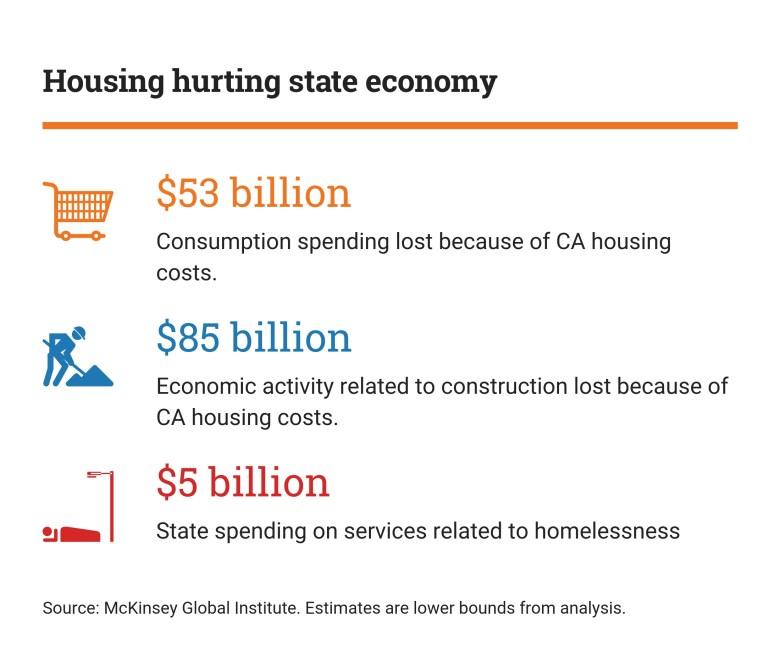Tenants and landlords are hurting, homelessness is skyrocketing and the housing market is out of control. The COVID-19 pandemic isn’t the only reason for that, but it’s making California’s longstanding housing crisis even worse.
In 2021, nine out of ten Californians consider housing affordability a problem, and nearly one in three Californians are considering leaving the state because of it, according to a March survey by the Public Policy Institute of California.
So how did things get so bad? Here’s what you need to know about California’s housing costs.
Just how hard is it to buy a home in California?
Hard. Really hard. Both compared to how difficult it is in other states, and how challenging it was for previous generations of Californians.
In the late 1960s, the average California home cost about three times the average household’s income. Today, it costs more than seven times what the average household makes.
While it’s always been more expensive to be a homeowner in California, the gap with the rest of the country has grown into a chasm. The median California home is priced nearly 2.5 times higher than the median national home, according to 2019 Census data.
The pandemic hasn’t cooled the housing market, either. Demand has long exceeded supply of homes for sale in California, and that’s especially true now. But while many families are suffering the economic impacts of COVID-19, wealthier households with money to spend and capitalizing on low interest rates have driven up prices even more. In September 2020, California’s median home price reached $712,430 — a historic high.
Who owns their house?
Despite relatively low mortgage rates, however, exploding housing prices have caused California’s overall homeownership rate to dip significantly. Just more than half of the state’s households own their homes — the third lowest rate in the country and the lowest rate within the state since World War II.
And those homeowners skew significantly white. White Californians are twice as likely as Black Californians to own their home, according to 2019 Census data. The racial gap in homeownership has widened over the years, which also means Black Californians are less likely to build wealth over time, said Carolina Reid, associate professor of city and regional planning at UC Berkeley.
But racial disparities are true in all dimensions of housing.
“Blacks and Hispanics are more likely to be cost burdened, more likely to live in overcrowded conditions, more at risk of eviction, and displacement,” she said.
Rents dipped with the pandemic, but are still soaring
Rents are among the highest in the country in California, home to seven of the ten most expensive cities for tenants. The pandemic has changed things up — driving down rents in some of the most expensive cities and hiking rents in some more affordable ones. But affordability overall has only worsened with COVID-19.
San Francisco remains the most expensive city to rent in the United States, with the average rent for a two-bedroom apartment at $3,500 a month, according to Zillow. That’s even after a 23% drop from last year. Fresno, at one point considered on the more affordable end of California housing, has seen a 39% hike in average rent since 2017, including a 12% increase during the pandemic.
The drop in homeownership plays a role here. As it has become more difficult to buy a home, wealthier people have remained stuck in the rental market — and driven up rent prices.
Wages can’t keep up with rental costs
Median earnings for Californians are higher than the national average, and are significantly higher in certain regions like the Bay Area. But on average, income over the past two decades has not kept pace with escalating rents.
Before the pandemic, about half of California renters were rent burdened, which means that more than 30% of their income went toward rent, according to the Harvard Joint Center for Housing Studies. Nearly a third of Californians were severely rent-burdened, which means that more than half of their income went toward rent.
The numbers are worse for families of color. A California Housing Partnership analysis found that in 2019, Black renter households were about twice as likely as white renter households to be severely cost burdened.
The pandemic only worsened these numbers. As unemployment skyrocketed and families lost wages, roughly one of every six tenants fell behind on rent payments, according to a study by the Little Hoover Commission.
It’s a statewide problem
The extremes of California’s housing crisis are concentrated in the Bay Area and greater Los Angeles, but the challenge is statewide. While San Diego, San Francisco and L.A. top the list of toughest rental markets in the country, cities including Sacramento and Fresno recently have experienced the largest year-over-year rent increases.
In most Central Valley cities, the majority of very low-income families are spending more than 30% of their paycheck on rent.
Homelessness is on the rise
The number of people experiencing homelessness is notoriously hard to track, but estimates are getting more accurate — and show that the problem is big, and worsening.
Newly released state numbers show that throughout 2020, nearly a quarter of a million people accessed homeless services through local agencies. About 160,000 were single adults, and nearly 85,000 in families with kids. Los Angeles County has the highest number of people experiencing homelessness, with about 90,000 people who accessed services in 2020.
That data — submitted by 42 of the 44 local agencies that manage homeless dollars and services across the state — was not previously compiled or made public. That number is dynamic, because someone may have been homeless at the start of the year, but housed by the end — or vice versa.
The data also fails to count some individuals who never interacted with homeless providers and survivors of domestic violence who are omitted for safety purposes, according to Ali Sutton, the state deputy secretary for homelessness.
According to the state, nearly 40% of those people, or 91,626 individuals, moved into permanent housing last year — which could mean anything from moving back in with a family member to getting their own place. This overlaps with an unprecedented amount of funding going to fix the issue — $13 billion over the last three years.
Previous estimates of people experiencing homelessness were much lower. Every two years, the federal government mandates a tally of the number of people on the streets on a single night in January. Advocates and experts have long clamored that the count is not accurate.
The point-in-time count was last taken in January 2020 — before COVID-19 ravaged the economy — and showed 161,548 people experienced homelessness in California. The January 2021 count was postponed due to COVID-19.
It’s really hard to pass legislation to build more housing in California
Sen. Scott Wiener takes a photo of the vote tally as the eviction
bill passes in the senate. (Photo by Anne Wernikoff for
CalMatters)

But that doesn’t stop lawmakers from trying, and trying again.
2020 was supposed to be a big year for housing legislation. Lawmakers proposed a slew of housing bills, including a measure that would have forced cities to allow more mid-rise apartment buildings, convert big-box retail property into housing, and limit the restraints of environmental law on housing projects.
None of those bills passed. Democratic squabbling and the global pandemic, among other factors, were to blame.
Key legislators are back at it this year. The bills are mostly designed at easing zoning and environmental restrictions to allow for more dense housing, funneling more money into affordable housing production and trying to force local governments to comply with state goals.
Here are a just a few of the bills we’re watching this year:
AB 215, by Assemblymember David Chiu, would essentially give teeth to the Regional Housing Needs Allocation, a law designed to increase housing production but that has done little to mandate it. Cities would need to check in with the state halfway through their eight-year housing approval process. If they’re behind on their goals, the state would force them to approve more pro-housing policies.
SB 9, by Senate leader Toni Atkins of San Diego, bears some resemblance to last year’s SB 50. The bill would allow homeowners to put a duplex on single-family lots or split them without requiring a hearing or approval from the local government. Affordable housing and rental properties would be exempt from the changes.
SB 10, by Sen. Scott Wiener, would allow cities to rezone transit centers and job hubs to allow as many as 10 units per parcel. Proximity to public transit would theoretically lead to fewer cars on the road, bringing the state closer to its goals to reduce climate change.
SB 478, also by Wiener, takes aim at local ordinances that limit the construction of housing based on lot size, which effectively erases any chance of building small apartment buildings on land that is already zoned for multi-family housing.
California’s most controversial homebuilding bill
Senate Bill 50, proposed last year by Sen. Scott Wiener, would have forced cities to allow more mid-rise apartment buildings around public transit and next to some single-family homes. Proponents believe this is the best and quickest way to come close to meeting the state’s housing needs.
A host of political interests supported the bill — developers, landlords, environmental groups, big city mayors and even Facebook wanted to see it pass. But the bill failed to get enough votes in the Legislature to survive in 2020 before time ran out. Among the opponents were Los Angeles Democrats, spurred by low-income tenant advocacy groups.
That wasn’t the first time the legislation failed.
Similar versions of the bill had been blocked twice before, with strong opposition from suburban homeowners, local governments and community groups who contended the proposal would destroy neighborhood character and gentrify lower-income communities.
“As disappointing as it was not to pass (Senate Bill 50), it left me quite optimistic about what we will be able to do in the future,” Wiener told CalMatters. “The fact that a bill four or five years before (SB 50) would not have probably even gotten a hearing in a single committee, but then we were able to get it through two committees and almost off the Senate floor (means) there is actually very, very broad and deep support for a pro-housing agenda.”
Many of the same ideas proposed in SB 50 will be up for debate again this year.
The housing crisis has major repercussions for the economy
Big business is also feeling the pinch of California’s housing crisis.
The McKinsey Global Institute found that housing shortages cost the economy between $143 billion and $233 billion annually, not taking into account second-order costs to health, education and the environment. Much of that is due to households spending too much of their incomes on the rent or mortgage and not enough on consumer goods.
Even the attractive salaries and lavish perks of Silicon Valley struggle to overcome the local housing market, as young tech talent flees to the relatively inexpensive climes of Austin or Portland. Nearly 60 percent of Los Angeles companies in a recent University of Southern California survey said the region’s high cost of living was affecting employee retention.
Bad news, California: People like to live in houses
California just doesn’t have enough housing to keep up with demand.
Over the past 10 years, California’s population grew by about 6.7%, while new housing grew by only 4.8%, according to data from the California Department of Finance.
Population growth has slowed down significantly. In 2019, the state for the first time added more housing units than people. But the picture might be less rosy than the numbers suggest.
A lot of people are still coming to California, but many of those leaving are likely being priced out, according to Department of Finance research data specialist John Boyne.
“I’m sure housing is a pretty major factor,” he said.
Unlike at the start of the decade, when California was on a single-family homebuilding binge, the recent increase in housing production consists mainly of multi-family housing and accessory dwelling units in the downtown areas of Los Angeles, San Francisco and San Diego, Boyne said.
That doesn’t mean they’re more affordable: Only 7% to 10% of the new units are designated as affordable, Boyne said.
Building new homes is an expensive business…especially in California
Part of the problem boils down to the (literal) nuts and bolts of housing development. Over the last decade, the cost of building multifamily housing in California has spiked by about 25%, according to a 2020 report by the Terner Center for Housing Innovation at UC Berkeley.
On average, each square foot cost $44 more to build in 2018 than it did a decade ago across the state. In the Bay Area, however, that cost jumped up by $81 a square foot, according to the Terner Center. And affordable housing was more expensive to build than market rate housing.
The reasons are many and complicated, but two big ones are more expensive materials and a shortage of labor. While permitted units spiked by 430% between 2009 and 2018, the number of workers has grown by only 32%. Experts attribute the lack of construction labor to anti-immigration rhetoric, a tighter overall labor market and depressed wages.
The California land rush
But construction costs are only part of the problem. And sometimes a relatively small part at that.
In most of the state’s major urban areas, the bulk of a single-family house’s price is locked into the land it sits on. That high price tag on the cost of actually buying a parcel and prepping it for construction not only makes new housing more expensive, it influences what kind of housing gets produced: developers prioritize high-end projects, since even the cheapest pre-fab unit will come stuck with a steep fixed cost.
What makes land expensive? When it’s in shortest supply. Take San Francisco: Seven-by-seven miles of hillside penned in by water on three sides. Of the top 15 most physically constrained metro areas in the country, seven dot California’s oh-so-desirable coast. But many of those same coveted locales place additional limits on where—and when and how and how much—construction can take place. That all makes it that much harder for housing to keep up with population growth. And over the last decade, it has not.
*An earlier version incorrectly referred to the structural value of single-family homes as construction costs.
If not in your backyard, then whose?
Who has cause to celebrate when a new housing project goes up in your neighborhood? Young homebuyers, nearby businesses, new arrivals to the area, and, of course, developers. But people who have been living in the neighborhood for years may worry that the new development will depress the value of the homes they own, or trigger increases in the rent they pay. Those who prefer not to live next door to a construction site, or watch their zucchini garden wither in the shadow of a garish new condo building, have plenty of reasons to object.
And object they do. With the exception of one irregularly enforced state law, land use planning in California is a local process—and one that affords opponents of change ample opportunity to stall, stymie, or scale down. The tool kit of local obstruction includes zoning restrictions, lengthy project design reviews, the California Environmental Quality Act, parking and other amenity requirements, and multi-hurdled approval processes. In California, you’re most likely to find these extra restrictions where developable space is already scarcest — in coastal urban enclaves.
Local pushback might be rooted in concerns about the environment, about congestion, about the creep of gentrification, or in a desire to preserve the “character” of the neighborhood (however that might be defined). But whatever the flavor of NIMBYism and whatever its ultimate goals, higher hurdles to development in the state’s most desirable locations mean many cities have failed to add new units fast enough to keep up with population or job growth.
And that inevitably means higher prices.
A lack of public dollars
A little recent history: In 2012, California began unwinding its redevelopment agencies, the local investment organizations tasked with revitalizing “blighted” areas across the state. By law, redevelopment agencies were supposed to provide a guaranteed stream of cash to cities for subsidized housing — 20% of any increase in property tax payments.
Much — in many cities, most — of that money didn’t end up going into the construction of new housing, but was instead siphoned off to pay for broadly defined “administrative activities.” Still, with the end of redevelopment came the end of the single largest source of non-federal money for affordable housing in the state. California lawmakers never plugged that hole.
Between 2013 and 2018, state investments in affordable housing dropped from an annual average of $1.3 billion to less than $500 million, according to the California Housing Partnership.
The state began reversing that trend in 2019, thanks to funding from SB 2, which dedicated about $250 million in annual revenues for affordable housing; about $5 billion worth of housing bonds from Proposition 1 and 2; and $500 million in state low-income housing tax credits.
But the new dollars will dry up by 2022, leaving developers without a stable funding source, said California Housing Partnership CEO Matt Schwartz.
“Politically you can understand the attraction,” Schwartz said. “At a mechanical, functional level, it creates huge amounts of extra work particularly for the nonprofit housers we assist.”
Getting around the NIMBYs
It’s hard to get people to agree on a solution when they don’t even agree on the problem.
Ask some politicians and much of the blame for California’s housing woes lies with local obstructionists. Take away the NIMBYs’ favorite procedural tools and the housing market will eventually build its way out of the shortage. President Biden, in his $2 trillion infrastructure plan, says that restrictions on multi-family zoning “drive up the cost of construction and keep families from moving to neighborhoods with more opportunities.”
But red tape has a powerful constituency. Its members include:
- City governments, which generally like having a say in what does and doesn’t get built within their borders. The powerful League of California Cities has opposed several measures to streamline the local housing approval process. It has called such efforts counter to the “the principles of local democracy and public engagement.”
- Environmentalists, who don’t want the Legislature tinkering with California Environmental Quality Act (CEQA). Pro-housing advocates argue that environmental concerns can be used as a pretext to hold up a project for any number of unrelated reasons. Cases in point: The law has been used in the past to block high-density housing and bike lanes. According to the Legislative Analyst’s Office, CEQA appeals delay a project by an average of two-and-a-half years.
- Building trade groups also benefit from the status quo. Any developer that uses public funds (in other words, anyone building affordable housing) is required to pay workers the most common rate for that job across the region. That “prevailing wage” tends to be set by the union rate. Labor groups have lobbied lawmakers to make prevailing wage restrictions a part of any housing fix. How much more expensive do union-level wages make housing projects? Experts differ with estimated cost increases ranging from 0 to 46 percent.
- Anti-gentrification activists, who often argue that developers should be saddled with more restrictions, not fewer. New houses may bring down prices over time, they argue, but for those who are facing eviction or displacement today, new, high-end development only makes a particular locale more attractive to outside investors and wealthy house hunters.
- Good old fashioned NIMBYs. In 2017, Marin County got a special exemption from the state’s housing development quota. What was the justification? According to one county supervisor, ramping up affordable housing construction wasn’t consistent with Marin’s “suburban character.”
What about Prop. 13?
You’d be hard pressed to find a single aspect of California life that isn’t affected by Proposition 13. Naturally, it gets blamed for an awful lot of the state’s problems.
So what about the cost of housing? After all, Prop. 13, California’s 1978 tax revolt initiative, capped property taxes at 1 percent of a home’s purchase price and limited the rate taxes can tick up each year by 2 percent. From a city’s perspective, giving your available land to new housing doesn’t make much sense if a sales-tax-paying restaurant or clothing store is waiting in the wings.
The Legislative Analyst’s Office looked into the question of whether the state’s capped property taxes distort local land use decisions. Their conclusion: a resounding “probably not.” In short, a city’s dependence on property taxes or sales taxes didn’t predict much about its land use decisions.
Even so, there are other ways in which Prop. 13 could be contributing to our affordability crisis. Another consequence of capped property taxes is that local governments have to scramble for other sources of cash. One of those sources is housing developers. On average, California levies the highest developer fees in the country, making it that much more difficult to build new housing.
CalMatters.org is a nonprofit, nonpartisan media venture explaining California policies and politics.
–
Stay up to date on the effects of the coronavirus on people and business in the Capital Region: Subscribe to the Comstock’s newsletter today.
Recommended For You

Is the Business Exodus to Texas Real?
Comstock’s president and publisher considers the apparent exodus from California to states such as Texas.

Boom From the Bay
The influx of high-skilled workers is boosting Sacramento’s economic prospects
Leaders in business and development say the trend could alter the trajectory of the region’s economy for years to come.

A Move to Midtown Might Not Be in the Cards
To open our annual housing issue, Comstock’s executive editor weighs the pros and cons of moving to Midtown Sacramento.

How the Remote Work Revolution Could Change California’s Housing Crisis
A huge number of people have been working from home for the better part of the year. The long-term implications for housing will likely benefit higher-earning workers and hurt lower income Californians.




